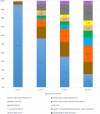Food consumption patterns and nutrient intakes of infants and young children amidst the nutrition transition: the case of Lebanon
- PMID: 35599326
- PMCID: PMC9125916
- DOI: 10.1186/s12937-022-00779-9
Food consumption patterns and nutrient intakes of infants and young children amidst the nutrition transition: the case of Lebanon
Abstract
Background: This is the first study on dietary intakes of infants and young children in the Eastern Mediterranean Region, a region that is currently witnessing the nutrition transition. It aims at characterizing food consumption patterns amongst 0-4 year old children in Lebanon, evaluating their macro- and micronutrient intakes and assessing adherence to dietary recommendations.
Methods: Based on a national cross-sectional survey in 2012 (n = 866), the study collected data on sociodemographic and anthropometric characteristics, and one 24-hour dietary recall was administered. Nutrient intakes were compared with reference values: Estimated Average Requirement (EAR), Adequate Intake (AI) and Acceptable Macronutrient Distribution Range (AMDR).
Results: Milk was the highest contributor to energy intake (EI) in infants (95.8 and 56.5% in 0-5.9 months and 6-11.9 months old infants, respectively), while its intake was lower among toddlers and preschoolers (35.4 and 15.1%, respectively). In contrast, intakes of sweets and sweetened beverages were the highest in preschoolers compared to younger children, contributing 18.5% EI in preschoolers. Compared to dietary guidelines, the lowest dietary adherence was found for vegetables (17.8-20.7%) and fruits (14.4-34.3%). Protein intake was within the recommendations for the vast majority of children. Although total fat intake was lower in toddlers and preschoolers compared to infants, more than 40% of toddlers and preschoolers exceeded the AMDR for fat and 87.3% of preschoolers exceeded the upper limit for saturated fat. Only 3.6% of toddlers and 11.5% of preschoolers exceeded the AI level for dietary fiber. Micronutrient intake assessment showed that mean intakes in infants exceeded the AI for all micronutrients, except for vitamin D and magnesium. In toddlers, vitamin D and calcium were below the EAR among 84.7, and 44.6%, respectively. In preschoolers, most of the children (91.9%) had inadequate intakes of vitamin D, and a third had inadequate intakes of folate, calcium and vitamin A.
Conclusions: This study identified priority issues for nutrition intervention in infants and young children in Lebanon. Concerted multi-stakeholder efforts are needed to instill heathier food consumption and nutrient intake patterns early in life.
Keywords: Adherence; Food consumption patterns; Food groups; Intakes; Lebanon; Macronutrients; Micronutrients; Nutrients; Under-five children.
© 2022. The Author(s).
Conflict of interest statement
The authors declare that they have no competing interests.
Figures


Similar articles
-
Food sources of fiber and micronutrients of concern among infants and young children in Lebanon: a national cross-sectional study.BMC Pediatr. 2024 Jan 19;24(1):57. doi: 10.1186/s12887-024-04535-2. BMC Pediatr. 2024. PMID: 38243229 Free PMC article.
-
Food and nutrient intake of school-aged children in Lebanon and their adherence to dietary guidelines and recommendations.BMC Public Health. 2022 May 10;22(1):922. doi: 10.1186/s12889-022-13186-w. BMC Public Health. 2022. PMID: 35534814 Free PMC article.
-
Nutrient intakes of US infants, toddlers, and preschoolers meet or exceed dietary reference intakes.J Am Diet Assoc. 2010 Dec;110(12 Suppl):S27-37. doi: 10.1016/j.jada.2010.09.004. J Am Diet Assoc. 2010. PMID: 21092766
-
Food Consumption Patterns and Nutrient Intakes of Children and Adolescents in the Eastern Mediterranean Region: A Call for Policy Action.Nutrients. 2020 Oct 30;12(11):3345. doi: 10.3390/nu12113345. Nutrients. 2020. PMID: 33143163 Free PMC article. Review.
-
Child and adolescent nutrient intakes from current national dietary surveys of European populations.Nutr Res Rev. 2019 Jun;32(1):38-69. doi: 10.1017/S0954422418000161. Epub 2018 Nov 3. Nutr Res Rev. 2019. PMID: 30388967 Free PMC article. Review.
Cited by
-
The dietary fiber and micronutrient composition of traditional foods from Lebanon and their contribution to dietary adequacy: A call for action.PLoS One. 2024 Oct 29;19(10):e0312429. doi: 10.1371/journal.pone.0312429. eCollection 2024. PLoS One. 2024. PMID: 39471186 Free PMC article.
-
Prevalence and Antibiotic Resistance of Staphylococcus aureus and Escherichia coli Isolated from Bovine Raw Milk in Lebanon: A study on Antibiotic Usage, Antibiotic Residues, and Assessment of Human Health Risk Using the One Health Approach.Antibiotics (Basel). 2022 Dec 14;11(12):1815. doi: 10.3390/antibiotics11121815. Antibiotics (Basel). 2022. PMID: 36551472 Free PMC article.
-
Association of Maternal Feeding Style with Fruit and Vegetable Consumption in Saudi Preschoolers: A Nationwide Cross-Sectional Study.Nutrients. 2023 Nov 9;15(22):4735. doi: 10.3390/nu15224735. Nutrients. 2023. PMID: 38004129 Free PMC article.
-
Sugar Reduction Initiatives in the Eastern Mediterranean Region: A Systematic Review.Nutrients. 2022 Dec 22;15(1):55. doi: 10.3390/nu15010055. Nutrients. 2022. PMID: 36615712 Free PMC article.
-
Food sources of fiber and micronutrients of concern among infants and young children in Lebanon: a national cross-sectional study.BMC Pediatr. 2024 Jan 19;24(1):57. doi: 10.1186/s12887-024-04535-2. BMC Pediatr. 2024. PMID: 38243229 Free PMC article.
References
-
- World Health Organization . Diet, nutrition and the prevention of chronic diseases. Report of a joint WHO/FAO expert consultation. Geneva: World Health Organization; 2003.
-
- Michaelsen KF, Weaver L, Branca F, Robertson A. Feeding and nutrition of infants and young children. Guidelines for the WHO European region, with emphasis on the former soviet countries. Copenhagen: World Health Organization; 2000.
Publication types
MeSH terms
Substances
LinkOut - more resources
Full Text Sources

